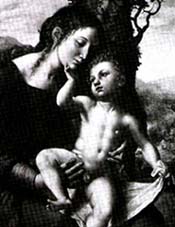OldSpeak
Naked Christs and Balaam's Ass: A Blueprint Toward a Renewed Christian Aesthetic
By Joshua S. Anderson
November 10, 2003
Christians are a people of the book. Our religion relies on God-inspired language to govern our theology, to pattern our worship, and ultimately to tell us who we are and what God does. With this in mind, it is significant that the Christian religion contains no divinely inspired images. Like children lying in bed as our father reads aloud to us, we are told the story, but allowed to imagine it as we like—and much can be learned from that imagining. God has given Christianity its words, but men have made its images. In the last two thousand years of Christian history, each age has illustrated the Bible in its own way, accentuating what it felt important, and neglecting the insignificant; indeed, much can be learned of the prevailing theology of an age by the kind of art it produces, and its attitude toward religious art in general.
 |
| Jan van Hemessen, Madonna and Child, 1543 |
In this spirit, Leo Steinberg’s book, The Sexuality of Christ in Renaissance Art and In Modern Oblivion, is fascinating for what it tells us about the Renaissance, and more importantly, what it implies about our own time. Published in 1984, and revised in 1996, Steinberg’s basic thesis is initially fairly disconcerting, as he posits that “Renaissance art, both north and south of the Alps, produced a large body of devotional imagery in which the genitalia of the Christ Child…receive [a] demonstrative emphasis.” Before your eyebrows shoot too high, consider this—Steinberg’s book contains 300 reproductions of Renaissance paintings, each proving his point in excruciating detail—in painting after painting the naked baby Jesus sits on his mother’s lap, legs spread to display himself, and often with his mother’s finger not-so-subtly pointing out the proof of her son’s masculinity. Alternately, Steinberg cites many nativity scenes where the visiting shepherds and magi kneel before the Christ Child’s displayed genitals, amazed at his obvious humanity. At the end, there is no choice but to nod in agreement when Steinberg concludes, “in many hundreds of pious, religious works, from before 1400 to past the mid-16th century, the ostensive unveiling of the Child’s sex…is the main action.”
But what is the meaning of this artistic emphasis on the genitalia of our Savior? Is it an insidious attack of Christ’s character? Is it tawdry fascination of a sex-obsessed culture? Is it merely to appall 21st century fundamentalists? Steinberg has a different explanation. The emphasis on Christ’s sex, he writes, is meant to underscore his biblical humanity. Indeed, the paradoxical nature of Christ’s incarnation, his simultaneous divinity and humanity, has always existed in tension throughout Christian history. In the theology of the Renaissance era, Christ’s divinity had already been firmly established, giving the artists of that age freedom to demonstrate, and reflect upon, the humanity of the Messiah. As is noted by Steinberg, “in the imagery of earlier Christianity, the claims for Christ’s absolute godhood, and for his parity with the Almighty Father, had to be constantly reaffirmed against unbelief—first against Jewish recalcitrance and pagan skepticism, then against the Arian heresy, finally against Islam.” The pendulum had swung far in emphasizing Jesus’ divine nature, and Renaissance artists were pulling the momentum back toward the incarnational tension. Displaying the masculinity of Christ was not the only way the artists instructed their audiences—Steinberg also shows paintings where the Christ Child stares out from the painting while nursing on the Madonna’s fully displayed breast, and others which focus on the circumcision of the infant Messiah. “Look,” the Renaissance artists seem to be saying to us, "consider the mystery and wonder of the Incarnation. See how the God-child’s body is like a man’s in every way. See how he suckles at his mother’s breast. See how he bawls when his blood is shed.”
Interestingly, Steinberg mentions only one example of a fully naked adult Christ, but it is a significant one. Less well-known than some of his other sculptures, Michelangelo’s Risen Christ portrays Jesus shortly after the Resurrection. In a style reminiscent of the artist’s David, Christ stands fully nude, his arms wrapped around a small cross. While the nudity is disconcerting, Michelangelo is using the brazenly naked body of the risen Christ to make a particular theological point. Paul writes in his letter to the Romans that Jesus lived as the second Adam; where the first Adam failed, Jesus succeeded. By leading a sinless life, embracing a sacrificial death, and finally being raised from the dead, Christ reversed the effects of the fall, conquering the penalty of sin, and removing the curse of shame. Biblically, the taboo against nudity was inherited as a result of the sin of Adam and Eve, who previously lived together “naked and not ashamed.” After the fall, God killed animals to make clothes and cover their bodies. Therefore Christ, as the triumphant and perfect Adam, is able to stand naked without shame. In Michelangelo’s sculpture, Christ’s resurrected nakedness also provides a foreshadowing of the reality he will bring upon his return—where the resurrected bodies of the faithful will again dwell together without sin, and consequently, without shame. As Steinberg writes in conclusion, “We may say that Michelangelo’s naked Christ…[is] like the naked Christ Child, not shameful, but literally and profoundly shameless.”
 |
| Joos van Cleve, Holy Family, c. 1515-1520 |
Indeed, the image and person of Christ have functioned as the most compelling subject of Western art in the two thousand years since his birth and death, and the god who became man still figures largely in contemporary art, though oft times is represented in ways that disturbs modern Christians. The most infamous example in recent memory is the media and congressional circus that surrounded Andres Serrano’s Piss Christ photographs. The crucifix submerged in a jar of blood and urine ignited a firestorm of reaction, notably frequented by evangelicals calling the government-funded art “blasphemous.” The conservative reaction is understandable. To urinate on something is the ultimate Western cliché of derision—one can hardly stop for gas without seeing a truck sporting a figure urinating on a despised NASCAR driver’s car number or rival manufacturer; in his photographs, Serrano must have known that he was speaking a particular cultural language by mixing urine and Christ, one that was certainly intended to offend. So, although the righteous indignation of evangelicals is certainly justified, if one can look past the obvious mockery of Christ, there is, ironically, a subtle (and almost certainly unwitting) affirmation of the profoundly good news of the Incarnation.
While it would be a mistake to call Serrano’s photographs great art in a technical sense—they were after all, something more like a concept than an actual creation—his work is not deprived of meaningful implications. When understanding Serrano’s work, it is important to note that he did not portray anything anti-Biblical in his photos. For example, Serrano did not represent Jesus in a sexual relationship with Mary Madelegne, as other contemporaries have. In contrast, Serrano’s mixture of Christ and urine is offensive, but not unbiblical, unless one holds to the Gnostic belief that Jesus was not completely human; indeed bodily functions are necessitated by concept of “the Word made flesh.”
 |
|
Andres Serrano, Piss Christ, c. 1989 |
In reality, the offensiveness of Piss Christ is due at least somewhat to the patently unbiblical nature of much current Christian art. That is, the submersion of Christ in a jar of urine is offensive to evangelicals at least partly because the humiliation and scandal of the Incarnation is, in practical terms, typically ignored in contemporary evangelical art. When a Christian artist draws a portrait of Jesus serenely cradling children in his lap, the artist is portraying the gentleness and love of Christ, and this kind of portrait certainly has value—but in ignoring the tension implicit in the divine and human natures of Jesus, contemporary Christian art is often deeply unbiblical. Despite his opposition to Christ (or perhaps because of it), Serrano provides an accurate understanding of the reality of the incarnate God; in his overt attempt at mockery, he establishes an important contrast to the candy-coated Christ found in most Christian bookstores.
In addition, it is significant that Serrano chose to submerge a crucifix in urine, instead of some other representation of Christ, for the Crucifixion is Jesus’ ultimate humiliation. When Christ humbled himself to become a man, it was an immense act of humiliation; but when the God-man was nailed, naked, to a plank of wood, tortured and killed in the most publicly shameful and excruciatingly painful method in human history, the humiliation is unfathomable. And yet, in Christian circles, the crucifix has become an incredibly commercialized product—one can wear Christian T-shirts with a cartoon Jesus on a cartoon cross, plug a crucifix night-light into the hallway outlet, or display a crucifix knickknack on the mantle. In this gross mass-production of Christ’s death, much of the scandal, and power, of his death has been lost. The offense evangelical Christians feel when viewing Serrano’s photographs is deeply correct, because their God is being humiliated and mocked—but that same sense of offense should also be felt on some level whenever any depiction of the Crucifixion is seen. And to the degree that the sense of offense has been lost in contemporary portrayals of the death of Christ, so too is the wonder.
 |
| Bartolommeo di Giovanni, Madonna and Child, c. 1490 |
The death and resurrection of Christ is the most mysterious and appallingly beautiful event in human history—prophesied in Genesis, all of the Old Testament longs for it, and all of Christian hope is built on it. God, naked and dying, is simultaneously the most tragic event in Scripture, the best joke, and the cause for the greatest and longest celebration—for the blameless scapegoat has been slaughtered and the power of death, the oldest enemy, is about to be shattered. And if Piss Christ jolts us out of our comfortable and vague sense of the Crucifixion, if it thrusts us face-to-face with the scandal and humiliation of the Incarnation, if it awes us again with the reckless and horrific beauty of the god who allowed us to pound nails through his bone and flesh, its profanity (inherent in the Incarnation itself) is forgivable and the art is, in the truest sense, “edifying.” While Serrano’s photographs could (and probably should) never have been made by a Christian, his attempt at overt mockery is actually subverted by a sovereign Christ who consciously humiliated himself far more than Serrano ever could have. Like Balaam’s ass, Serrano’s photographs are a base tool which shake us out of our complacency into a more complete understanding of Jesus’ death.
The work noted in Steinberg’s book, coupled with Serrano’s photographs, provide a compelling outline of the theologically insightful and radically unsentimental themes Christian art is capable of illustrating. To return to the opening metaphor, if we are the children lying in bed, then we are listening to the greatest story ever told—and surely we can imagine it better than the cliché-ridden, inoffensive kitsch that is produced by much of the evangelical world today.
Therefore, in the hope of a renewed Christian aesthetic, I would argue for three crucial elements in our art. First, we must produce art that is both theologically orthodox and Biblically offensive—that respects the historical boundaries of Christian belief, while authentically interacting with the text, and not veering away from the difficult parts of Scripture. An example is Barry Moser’s illustrations of the King James Bible, which includes portraits of the aftermath of the rape of Tamar, a detailed study of the Angel of Death, and a portrait of the graphic death of Absalom. This is not to discount Psalm 23 depictions of the good shepherd. The “gentle” parts of scripture must not be neglected, but rather balanced—for the Bible is not a Disney cartoon, and it is both deeply unbiblical, and theologically dangerous, to treat it as though it were. Second, Christian art should be aesthetically excellent. There seems to be an unwritten rule that if a Christian paints a picture of Jesus, we should not criticize it, no matter how awfully it is done. This is shameful—Christ has redeemed all spheres of life, and Christian artwork should be held to higher artistic standards, not lower. As in all of life, the quality of Christian art is significant, because its quality glorifies its ultimate Creator. Finally, Christian artwork should be radically unsentimental. We must paint new paintings, find new metaphors (or, as Steinberg shows, rediscover old ones) to reflect the symphony of the Christian story. Indeed, the main act of Christian art must be to hold our hands to the flame, to reveal again, as if for the first time, the wonder and strangeness of the scriptural narrative as it sings the beautiful, and terrible, tale of the reckless love of God. For when we delight in the story—as we plumb its mysterious depths, laugh at its jokes, sigh at its tragedies, and celebrate its triumphs—we bring glory to the ultimate Storyteller. This, in the end, is the work of Christian art—to faithfully and excellently tell the story of God’s continuing work, in order to better glorify Him. And Steinberg’s naked Christs, along with Serrano’s “Piss Christ,” though imperfect and perhaps unwitting examples, help show us the way.
DISCLAIMER: THE VIEWS AND OPINIONS EXPRESSED IN OLDSPEAK ARE NOT NECESSARILY THOSE OF THE RUTHERFORD INSTITUTE.


